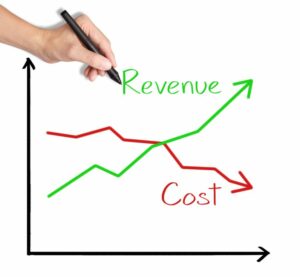It takes about $100 of revenue to add $10 of profit, but it only takes $10 of cost savings to add $10 of profit. So, would you rather increase revenue, or reduce costs?

Sales Executives generally think their role is to generate revenue, and they are mostly, but not entirely, correct. They can also make a serious contribution to cost containment if they pay attention to it. The problem is, sales rarely gives enough thought to what happens to a project once they hand it off — or drop it off — until someone downstream squawks.
Here are some ways that Sales Reps can influence future, often avoidable, costs.
Needs analysis
More robust discovery and discussion with the Client prevents callbacks, engineering questions, delays in design, and miscommunication about Client expectations. No, this job isn’t “just like the last one”, and interview shortcuts can be costly. Do they:
-
- follow a checklist,
- document what was discussed, and
- verify functionality expectations with the Client?
If not, they not only forfeit available margin, they make themselves and the company look bad.
Site surveys
Too often, Sales Reps do more of a “drive-by” than a “walk through” site survey. They may rely on old drawings, take the Client’s word for inventory or the condition of owner-furnished equipment (OFE), do the site survey without the Client, or fail to document the survey with information and annotated photos. Then they (or someone else) has to go back to finish the job. Again added time and cost. The Sales pro will engage the Client — and even point out site challenges likely to increase the estimate to come.
Scopes of Work
Work scopes that are sloppy, incomplete, or aimed only inwardly at the Engineers do several things, and all of them are bad. Scopes need to be written to and for the Client to validate performance and functionality expectations and other project considerations. They need to be accurate and thorough, not only to make sure the Client “bought what you sold” and to avoid the threat of “scope creep”, but to set the stage for possible change orders that may arise.
Estimate manipulation
If there are constraints, concerns, or sensitivities attached to the job, discuss this with Engineering rather than manipulate information to produce the estimate you want — especially when you know it can’t be fulfilled. Don’t blind-side the folks downstream. They are on your side — they’re not the competition or the enemy.
The Sales Pro pays attention to both Clients at each of the above steps: the external one and the internal one.
They know that it takes about $100 more revenue to add another $10 of profit, but when you reduce costs, every dollar saved goes directly to profits.
Most people can only do one of those at a time.
Savvy sales people can do both.
This is a guest blog post from our partners at Navigate Management Consulting. For more information about these subjects, or with help in putting them to work, contact Navigate at

